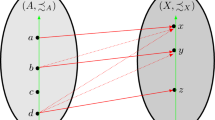Abstract
The paper deals with the problems that arise while developing software of such distributed systems as real-time, computer network protocols and distributed information-processing systems. In the introduction, some essential peculiarities typical of distributed systems (DS) and a general scheme for developing such systems are presented. The main idea of this paper is the use of a piece-linear aggregate mathematical method for formal specification, simulation and validation of DS. The main advantage of this approach is that it integrates two tasks of differing nature, i.e. simulation and correctness analysis of specification, on the basis of a single specification. The method of a transformation of aggregate specification to the first-order predicates and its further use for the correctness analysis of the aggregate specification using logic-based programming will also be presented. It will also be shown how to transform an informal description of system functioning to aggregate specification using production rules. The presented methods are explained using illustrative examples.
Similar content being viewed by others
References
Budnikas, G. (1996) Analysis of conceptual descriptions using knowledge representation models, MSc thesis, Kaunas (in Lithuanian).
Buslenko, N., Kalashnikov, V. and Kovalenko, I. (1973) Lectures on Complex Systems, Soviet Radio, Moscow (in Russian).
D'Alameida, J., Achuthan, R., Radhakrishnam, T. and Alagar, V. S. (1992) Transformation of semi-formal specifications to VDM, in KBSE'92 Proceedings, pp. 40–49.
Johnson, W. L., Feather, M. S. and Harris, D. R. (1991) The KBSA requirements/specification facet: ARIES, in KBSE'91 Proceedings, pp. 48–56.
Kelly, V. E. and Nonnenmann, U. (1988) Reducing the com-plexity of formal specification acquisition, in Proceedings of the AAAI-88 Workshop on Automating Software Design, pp. 66–72.
Lamport, L. and Lynch, N. (1990) Distributed Computing: modes and methods in Handbook of Theoretical Computer Science, van Leeuwen, J. (ed.), Elsevier Science Publishers, Amster-dam.
Lynch, N. A. (1996) Distributed Algorithms, Morgan Kaufmann Publishers, San Francisco.
Milner, R. (1980) A Calculus of Communicating Systems, Springer-Verlag, Berlin.
Miriyala, K. and Harandi, M. T. (1991) Automatic derivation of formal software specifications from informal descriptions. IEEE Transactions on Software Engineering, 17, 1126–1142.
Pranevicius, H. (1982) Models and Methods for Computer System Investigation, Mokslas, Vilnius (in Russian).
Pranevicius, H. (1991) Aggregate Approach for Specification, Validation, Simulation and Implementation of Computer Network Protocols, Lecture Notes in Computer Science 502, Springer-Verlag, Berlin, pp. 433–477.
Pranevicius, H. and Budnikas, G. (1996) The use of knowledge representation models for ESTELLE/Ag specification crea-tion. Information Technology and Control, 2(3), 29–33.
Pranevicius, H. and Ceponyte, R. (1995) Correctness analysis of aggregate specifications by means of logic programming. Information Technology and Control, 1, 35–43.
Pranevicius, H. and Panevezys, A. (1988) Proof of correctness technique for aggregate models of protocols, in IFAC/IMAC Symposium on Distributed Intelligence Systems, Varna, pp. 100–105.
Pranevicius, H., Pilkauskas, V. and Chmieliauskas, A. (1992) Knowledge-based specification editor for protocol analysis system, in Tool and Environments for Developing Control Systems, Kaariku, pp. 34–48.
Pranevicius, H., Pilkauskas, V. and Chmieliauskas, A. (1994) Aggregate Approach for Specification and Analysis of Com-puter Network Protocols, Technologija, Kaunas.
Reichgelt, H. (1991) Knowledge representation: an AI Perspective, Ablex Publishing Corporation, Norwood, NJ, p. 251.
White, D. A. (1991) The knowledge based software assistant: a program summary, in KBSE'91 Proceedings, pp. 2–6.
Yonezaki, K. J. (1989) Natural language interface for require-ments specification. Japanese Perspective in Software Engineering, 685–688.
Author information
Authors and Affiliations
Rights and permissions
About this article
Cite this article
PRANEVICIUS, H. Formal specification and analysis of distributed systems. Journal of Intelligent Manufacturing 9, 559–569 (1998). https://doi.org/10.1023/A:1008892320448
Issue Date:
DOI: https://doi.org/10.1023/A:1008892320448




